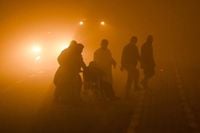A massive sandstorm swept across Iraq on April 15, 2025, closing airports and sending more than 3,700 people to hospitals with severe respiratory issues, according to the health ministry. The storm blanketed central and southern regions in an eerie orange haze, reducing visibility to less than one kilometre and forcing the closure of Basra and Najaf airports.
Health ministry spokesperson Saif al-Badr reported that the storm had a particularly harsh impact on Basra, where over 1,000 hospital admissions were recorded. In total, 3,747 individuals sought medical treatment across various provinces, with Baghdad alone accounting for at least 1,014 cases. The southern province of al-Muthanna also reported 874 cases, highlighting the widespread nature of the health crisis. Most patients were treated for dust inhalation and respiratory distress, and thankfully, no fatalities were reported.
Images captured during the storm depicted residents in Basra navigating nearly empty streets, many wearing face masks to shield themselves from the choking dust. The storm's intensity was so severe that it permeated homes and vehicles, coating every surface and making it nearly impossible for people to carry out daily activities. Emergency responders and police officers working outdoors wore masks and wrapped cloths around their mouths to protect against the harsh conditions.
The storm originated in eastern Saudi Arabia, where heavy waves of dust were picked up and carried into southwestern Iraq. While sandstorms are not uncommon in Iraq, experts warn that climate change is making them more frequent and severe. The United Nations has classified Iraq as the fifth most vulnerable country to climate change, citing rising temperatures and diminishing water availability as significant concerns.
Despite the sandstorm being a common occurrence during the winter and early spring months, the environment ministry has noted an alarming increase in the number of "dust days" expected in the coming years. This latest storm echoes a similar incident in 2022, which resulted in over 5,000 hospitalizations and one death.
As the storm began to dissipate on Tuesday morning, residents cautiously ventured outside, still wearing masks and trying to navigate the dusty aftermath. The health ministry confirmed that most of those admitted to hospitals had since been discharged, indicating that while the storm posed immediate health risks, the situation was under control.
In response to the storm, local authorities issued guidelines for families, advising parents to explain the frightening sounds associated with the storm to their children to help them cope. The Basra police department emphasized the importance of staying indoors and protecting oneself from the dust.
Climate experts are increasingly concerned about the implications of such severe weather events on public health and infrastructure in Iraq. The combination of desertification, prolonged droughts, and climate change is expected to exacerbate the frequency and intensity of sandstorms, posing a growing challenge for the region.
In summary, the sandstorm that swept through Iraq on April 15, 2025, serves as a stark reminder of the impact of climate change on the environment and public health. As the country grapples with worsening weather events, the need for effective strategies to mitigate these challenges has never been more urgent.







